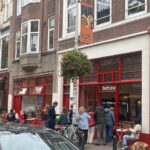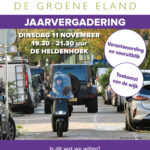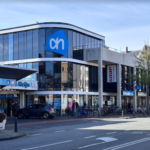Monumentale Hemsterhuisbrug in ere hersteld

TEKST EN FOTO’S WYBE VAN DE KUINDER
ENGLISH BELOW
Bruggen en kades hebben onderhoud nodig. Voor de fiets- en voetgangersbrug bij de Hemsterhuisstraat werd dat de hoogste tijd. Er zijn niet veel meer van deze prachtige monumenten. Bovendien, samen met een ander Rijksmonument, de loopbrug bij de Boomsluiterskade, zijn dit in Den Haag de enige nog overgebleven bruggen van IJzergieterij en -pletterij Enthoven uit Den Haag. Daar moet je zuinig op zijn.
De brug dateert uit 1885. Het brugwachtershuisje heeft er tot het begin van de tweede wereldoorlog gestaan. Omdat de kades aan het verzakken waren werd het draaimechanisme van de brug in de zestiger jaren vastgezet. Toen besloten werd de kades te vernieuwen moest ook de draaibrug vervangen worden. In de honderddertig jaar van zijn bestaan zijn de eisen veranderd zodat in eerste instantie werd gedacht aan het verhogen van de brug. Na het inzien van de plannen heeft Stichting SOS Den Haag in mei 2018 met medewerking van bewonersorganisaties, erfgoedstichtingen, vrienden en rondvaartbedrijven gepleit voor een volledige restauratie.
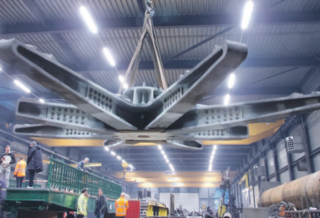
De spin, het draaibare deel van de brug. Hier nog ongeverfd in de fabriekshal van Van der Zalm.
Dat betekende dat het mechanisme dat de brug draaiend maakt hersteld moest worden. De firma Van der Zalm in Brakel werd uitgekozen om de klus te klaren. Omdat IJzergieterij en -pletterij Van Enthoven al in de zeventiger jaren is opgeheven vond men in Spanje, in de buurt van Bilbao, een bedrijf dat de ‘spin’ (het deel van de brug dat bij het draaimechanisme hoort) opnieuw van gietstaal kon vervaardigen.
Zoals de omstanders op 16 januari jl. konden zien, is dat goed gelukt. Er werd vroeg in de ochtend begonnen de ‘spin’ te bevestigen. Die moest recht boven de spil worden geplaatst. Een niet eenvoudige klus voor een gietijzeren deel dat enkele tonnen weegt en in de kabels hangt. Gelukkig was het nagenoeg windstil. Twee uur daarna kwam de beurt aan het brugdek. Dat moest ook weer exact passen op de ‘spin’. Na enig passen en meten viel ook die op zijn plaats. Wat nu nog rest is het aansluiten op de elektrische installatie en het testen. En natuurlijk worden er ook weer monumentale lantarenpalen op de brug geplaatst.
Maar dan, als de kruising Veenkade/Hemsterhuisstraat opnieuw bestraat is, heeft het Zeeheldenkwartier via een erg mooie brug voor fietsers en wandelaars directe aansluiting op het Kortenbos en het Centrum. Nu nog ‘even’ die twee andere bruggen (bij het Piet Heinplein) en dan is het Zeeheldenkwartier ‘klaar’ en hoeft er tot begin volgende eeuw niet meer gewerkt te worden aan brug- en tramverbindingen. Het is de bedoeling dat dit schitterend monument ergens eind maart feestelijk wordt heropend. Zorg dat u erbij bent. In nummer 2# van het Zeeheldennieuws laten we u weten wanneer.
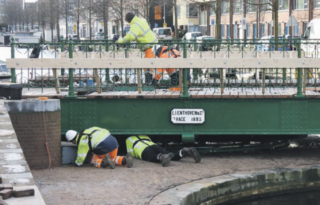
Installatie van de brug
ENGLISH
Monumental Hemsterhuisbrug Restored to its Former Glory
TEXT AND PHOTOS WYBE VAN DE KUINDER
TRANSLATION CINDY HOCK
Bridges and quays need maintenance. For the bicycle and pedestrian bridge at the Hemsterhuisstraat, it was high time. There are not many of these beautiful monuments left. Moreover, together with another national monument, the footbridge at the Boomsluiterskade, they are the only remaining bridges in The Hague made by the Iron Foundry and Plattery Enthoven of The Hague. You have to cherish them.
The bridge dates from 1885. The bridge keeper’s house stood there until the beginning of the Second World War. As the quays were subsiding, the bridge’s swing mechanism was fixed in the 1960s. When it was decided to renew the quays, the swing bridge also had to be replaced. In the one hundred and thirty years of its existence, the requirements have changed so that initially it was thought of raising the bridge. After seeing the plans, in May 2018, SOS The Hague Foundation, with the participation of residents’ organisations, heritage foundations, friends, and canal companies, advocated for a full restoration.

De spin, het draaiende deel van de brug
This meant that the mechanism that makes the bridge rotate had to be repaired. The Van der Zalm firm in Brakel was chosen to do the job. Because the Iron Foundry and Plattery Van Enthoven had already been closed down in the 1970s, they found a company in Spain, near Bilbao, that could manufacture the ‘spider’ (the part of the bridge that is part of the rotating mechanism) from cast steel again.
As onlookers could see on 16 January last, it worked out well. A start was made early in the morning to attach the ‘spider’. This had to be placed right above the pivot. Not an easy job for a cast-iron part that weighs several tonnes and hangs in the cables. Fortunately, it was virtually windless. Two hours after that it was the turn of the bridge deck. Again, this had to fit exactly onto the ‘spider’. After some
fitting and measuring, it too fell into place. What remains now is to connect it to the electrical system and test it. And, of course, monumental lampposts will be placed on the bridge again.
But then, once the Veenkade/Hemsterhuisstraat intersection has been repaved, the Zeehelden district will have direct connections to the Kortenbos and the city centre via a very nice bridge for cyclists and pedestrians. Now ‘just’ those other two bridges (at the Piet Heinplein) and then the Zeehelden district will be ‘finished’ and there will be no need to work on bridge and tram connections until early next century. This magnificent monument is scheduled to be festively reopened sometime in late March. Make sure you are there. In issue #2 of the Zeeheldennieuws, we will inform you when.


